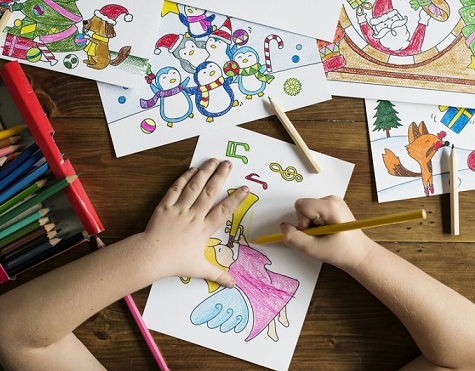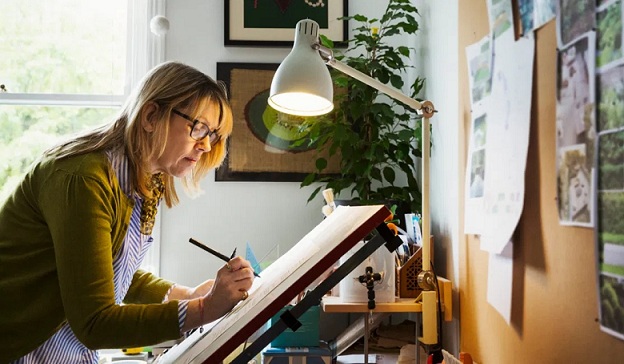Products You May Like
For many, the new normal includes a lot of virtual meetings.
We need to connect right now. However, screen time may still issue. Nor does it give us the movement or touch we desire.

This summer, I did consultative work with new students at my Unitarian church. I told the director of education, LeeAnn Williams, about their difficulty in getting involved.
His simple solution surprised me.
“Just let the students go for 2 minutes first. They love it, and it helps them stay focused, even in Zoom,” said Williams.
I always thought doing doodling was a bad habit for small orders, like putting your feet on the furniture. Teachers scold me for doodles in the papers, and my children received marks marked with drawings on the edges.
Williams leads the adult meditation phase, however. And the way he did it made me think.
I decided to consult with him and two other experts who will be doing the doodling. Yes, they are.
Tracey Trussell is an illustrator who is interested in doodling analysis. Sunni Brown is a well-known consultant, best-selling author of “The Doodle Revolution,” and the founder of Deep Self Design.
Based on scientific research, these interviews make the convincing case that doodling is not a bad practice.
It is a habit for many. It can also help reduce the overload of technology you may feel during the epidemic.
Defining Doodling
Doodle usually means “Writing Carelessly.”
Brown opposes the common denominator, along with his colleagues “kissing, making meaningless marks.”
Brown’s insight into doodling – which informs his books “Doodle Revolution” and “GameStorming” and his Ted speech – “makes automatic marks on your mind and body to help you think.”
Brown told me that doodling is a great, well-used learning tool.
“Everyone is encouraged to write words and speak,” said Brown, “whether one wants to be a writer or a speaker. Why not in a visual language?”
Brown uses “into doodles” to explore, express, and teach new ideas. He shared these creative conversations on his Flickr page.
Although each has some different spins from what the doodle means, Williams, Trussell and Brown agree on one key point: Making your mark with doodling makes sense.
Thoughtful Drawing
Williams made and guided others in what he called “thoughtful, purposeful penetration, leading you to a visible, quiet place.”
He calls this “meditation.” For some, the process is a spiritual one.
Often, Williams asks workshop participants to put a picture, person, or idea they would like to “keep in their heart” in the middle of their page. Participants made pen strokes such as clouds, curlicues, or bubbles around the centre.
“It’s a way to create time and space without words and relaxation,” Williams said.
He also suggests that those interested in self-examination can try the Zentangle method.
Created by Rick Roberts and Maria Thomas, it’s easy to relax by drawing beautiful, orderly patterns. Doodlers may find that ready-made designs are relaxed and focused, especially when working or studying remotely, you already feel very uncomfortable.
There are plenty of other exercises you can think of online, too. Here’s what the art coach suggested.
Drawing like a Daydream
Russell’s definition of doodling is a much older school than Williams or Brown because he does not see doodling as a goal.
“It’s like a dream in advance,” he told me, “something we usually do at autopilot, whether we’re focused on something, or when we’re tired, fixed, and our mind wanders.”
However, Trussell finds that the miracle of doodling is healing and vital.
“A real doodle is drawn on a single continuous line, where the pen can be removed from the page,” said Russell. “Usually, the composition is the most popular form of the booth and is full of symbols. The situation is related to people’s attitudes, lifestyle, needs, motives, responses, and attitudes.”
Science supports the idea that doodling improves intelligence, spirituality and problem-solving.
Benefits of Doodling
Besides being a fun way to get through a long meeting, doodling has many benefits.
Rest
Dealing with the epidemic is stressful – even the Centers for Disease Control and Prevention (CDC) Trusted Source says. Meanwhile, scientists, artists, and educators agree that doing doodling is relaxing.
One 2016 study of 39 university students, staff, and technology found that 75 per cent of participants had low levels of cortisol (stress hormones) in their saliva after performing the art. It didn’t matter if the artist represented or wrote “just”.
Some participants were artists; some were not. Making art was an equal opportunity to get discouraged.
Emotional Control
These days, people spend a lot of time indoors, away from social and community support groups. This means that addictive behaviours such as overindulgence and device use are increasing.
Of course, there is no easy solution to these problems. Finding simple sources of happiness can help.
Doodling can be such a joy.
In 2017, researchers at Drexel University in Philadelphia evaluated brain function measured by participants’ infrared light between three types of creative expression:
- colouring
- doodling
- free drawing
All three works of art, especially doodling, work reward pathways in the brain.
Researchers have concluded that “art can be used to control emotions [and] addiction behaviour.”
Memory
According to a highly cited 2009 study by Jackie Andrade, “role-playing participants, intended as an analogue of distilling of nature, are more focused on humorous messages than participants who listen to the message without having a single activity.”
Andrade is a professor of psychology and co-head of the School of Research at the School of Psychology at the University of Plymouth, England.
He found that doodling improved concentration by keeping participants awake and alert during tedious activities while preventing complete disruption of dreams.
On a smaller scale, University of British Columbia medical student Michiko Maruyama conducted a case study in 2012 to suggest that doodling remodelling in response to speech helps remember and understand.
Creativity and Authenticity
Trussell says doing doodling provides a way to express yourself to all people, regardless of their background or gender.
“When you do a doodle,” says Russell, “there is a complex interaction between the eye, the brain, the central nervous system, and the hand…. In other words, doodling and handwriting indicate brain function. psychological, emotional, paper.”
Trussell emphasizes that this is not what we do – it is the way we do it.
The doodle is drawn, how big it is, and the amount of pressure all say something about the doodler’s attitude.
Trussell believes that doodling “can provide important insights into a student’s personality and attitude.”
The self-portrait provided by doodling can be a welcome break from performance on the Zoom meeting stage.
Problem-Solving
Brown explains how the telecommunications company he worked with learned to think less in terms of doodling.
The company initially had no process in place of visual thinking. After some practice in targeted doodling, they were able to discover five new patents of patented technology. Previously they did not.
Brown told me that because doodling is a visual, written, zoomed, and emotional concept, it can enhance learning and creativity in a way that just one way of doing it is impossible.
Brown says he and his clients, this diverse experience, is a way to fight more time online.
